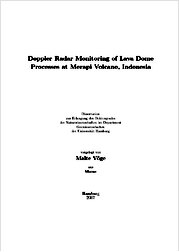Doppler radar monitoring of lava dome processes at Merapi Volcano, Indonesia
Vöge, Malte
Univ. Hamburg
Monography
Verlagsversion
Englisch
Vöge, Malte, 2007: Doppler radar monitoring of lava dome processes at Merapi Volcano, Indonesia. Univ. Hamburg, 156 S., DOI: 10.23689/fidgeo-319.
 |
View/
|
Merapi volcano in Central Java, Indonesia, is considered one of the most dangerous volcanoes worldwide. Due to the high viscosity of its magma, the lava emerging at the top the volcano cannot flow silently down the flanks of the volcano but builds a lava dome. An indicator for the stability of the lava dome are rockfalls and block and ash flows, which are caused by local instabilities at the dome. When the lava dome reaches a critical size, it collapses. This results in dangerous block and ash flows, which can reach several kilometers into the proximity of the volcano. In the past rockfall and block and ash flow activity has been observed visually or by seismic networks. However, visual observations are often impossible due to bad visibility conditions and until now seismic measurements allow only few insights into the dynamic processes that are involved in instability events, i.e. events of material breaks off the lava dome. In order to enhance monitoring of lava dome activity, a first prototype Doppler radar system has been installed at the western of the Merapi in October 2001. This system consists of a frequency modulated continuous wave (FMCW) 24GHz Doppler radar. The Doppler spectra recorded by the system give a relative measure of the amount of material moving through the beam as well as information about its velocities. Because the radar system is insensitive for clouds, the system provides first continuous "quasi-visual" observations of dome instabilities...

